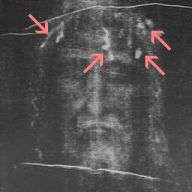
MYSTERIES FROM THE HOLY LAND | ||
|
THE SHROUD OF TURIN:
STARTLING NEWS FROM A STRANGE SOURCE |  "First there are what we may define as the superficial facial wounds, perhaps the least obvious to a layman, but readily discernible to the eye of a qualified physician. Dr. Willis listed these wounds as follows: swelling of both eyebrows, torn right eyelid, large swelling below right eye, swollen nose, triangular-shaped wound on right cheek with apex pointing to nose, swelling to left cheek, swelling to left side of chin. "These injuries are readily in harmony with the gospel accounts of Christ being struck repeatedly on the face, both at the hands of the High Priest's men and Pilate's soldiers, prior to the sentence of crucifixion." "Only one has flowed almost vertically, at least seven have veered to the left and three to the right. They have been caused by independent puncture wounds of the scalp, which bleeds freely when injured, and they tend to expand as they descend. They have been halted on the nape of the neck along a line convex downwards which, assuming them to have been caused by something like a cap of thorns, would seem to be at the level where the thorn-branches had been secured to the back of the head. The different directions of the flows would suggest a tilting of the head at various times during the wearing of the spiky cap. Turning to the front, there are similar puncture wounds with their counter-drawings of bloodflows but not so numerous as on the back. There are four or five that start from the top of the forehead moving down towards the eyes and the remainder are tangled in the masses of hair framing the face. The most striking of these flows is one in the shape of a reversed three and repays detailed study, so true to life is it. It starts just below the hairline to the left of the midline from a single wound; the flow then moves down to the medial part of the arch above the left eye following a meandering course obliquely and outwards. As the stream descends it broadens and alters course twice, finally building up and spreading out horizontally to the mesial line. Immediately below but separate is a "tear" of blood close to the eyebrow, which is presumably part of the same flow, or possibly from an independent wound. The reason for the meandering course of this vivid mark indicates that it met some obstruction in its downward course, and most likely this was due to the reflex contraction of the muscles of the brow from the pain of the wounds, furrowing the surface" (Wilson).  "As Dr. Willis found, it is quite impossible to talk sensibly about wounds such as these except in the context of a crown, or as it seems most likely to have been, a cap of thorns as described in the mockery of Christ as King of the Jews. Equally, as one reads such a description from a qualified physician, one cannot fail to be caught up by his own conviction of the sheer physiological logic of these wounds. Willis was not alone in this regard. Vignon too was fascinated by the thorn wounds, particularly the one shaped like a numeral three, which he too found entirely faithful to scientific and physiological detail. As he remarked, 'No painter, in his most elaborate work, has ever risen to such exactitude. (Wilson)" | |